

Makerspace. Makerspace. 5 Best 3D Printers - Dec. 2015 - BestReviews. The FlashForge Creator Pro's variable speed (up to 100 mm/s) makes it among the fastest in its class.

Each of our finalists deserves its place in this review, but the best 3D printer is, without doubt, the FlashForge Creator Pro. It's built on the same foundation as the well-known and highly respected Makerbot Replicator, yet it only costs around half as much. 3D Printing - k12irc.org. 3D printing can add a new dimension to the classroom (pun intended).
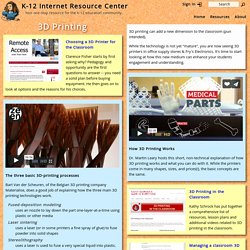
While the technology is not yet "mature", you are now seeing 3D printers in office supply stores & Fry's Electronics. It's time to start looking at how this new medium can enhance your students engagement and understanding. Choosing a 3D Printer for the Classroom Clarence Fisher starts by first asking why? Pedagogy and opportunity are the first questions to answer -- you need a solid plan before buying equipment. How 3D Printing Works Dr. The three basic 3D-printing processes Bart Van der Scheuren, of the Belgian 3D printing company Materialise, does a good job of explaining how the three main 3D printing technologies work. LittleBits Tips & Tricks: The Sound Trigger Bit. June 26, 2013 AT 9:10 am This is the first in an on-going series of posts about littleBits.
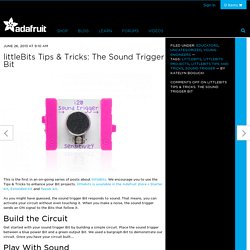
We encourage you to use the Tips & Tricks to enhance your Bit projects. littlebits is available in the Adafruit store – Starter Kit, Extended Kit and Teaser kit. As you might have guessed, the sound trigger Bit responds to sound. That means, you can activate your circuit without even touching it. When you make a noise, the sound trigger sends an ON signal to the Bits that follow it. Get started with your sound trigger Bit by building a simple circuit.
The Sound trigger responds to all sorts of sounds. You can adjust the sound trigger to respond to different ranges of sound. Cheap flying Lego quadcopter - English. 10 Breadboard Projects For Beginners. Before you start making the projects, you should understand the functioning of every project to know what are you really doing.
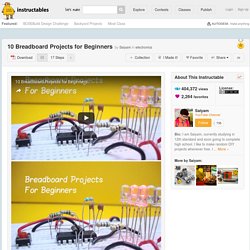
For this you need to know about important electronics components used in a circuit. So here is a brief description of all the electronic components used in the projects. I have left the ones that are not used in the projects and are too complicated to understand. Check out randofo's Basic Electronics guide that teaches you almost everything about basic electronics. Clap Switch (Simple, illustrated, you can build it)
Makerspace. 3D printing. EDUT 522 resources. Marble_machines.pdf. School Makerspaces: Building the Buzz. If you build it, will they come?
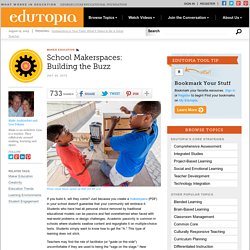
Just because you create a makerspace (PDF) in your school doesn't guarantee that your community will embrace it. Students who have had all personal choice removed by traditional educational models can be passive and feel overwhelmed when faced with real-world problems or design challenges. Academic passivity is common in schools where students swallow content and regurgitate it on multiple-choice tests. Students simply want to know how to get the "A. " This type of learning does not stick.
Teachers may find the role of facilitator (or "guide on the side") uncomfortable if they are used to being the "sage on the stage. " Want Cardboard? Here’s how to make (or buy) Google’s DIY VR headset at home. Starting a School Makerspace from Scratch. With the National Week of Making behind us, you might be ready to start a makerspace in your school -- but not know where to start.

Will purchasing a costly 3D printer and the latest robotics kit ensure learning and maker success? What are some steps to starting a successful makerspace from scratch? Step 1: Immerse Yourself in Maker Education Before you can build your own community of makers, you need to join one! Edutopia. While many teachers are excited about the maker movement and may even be creating projects for their classrooms, assessment can be puzzling even to veteran classroom teachers.

How can teachers prove that deep, rich learning is occurring through making? How do we justify a grade to students and parents alike, especially to the student who "just isn’t good at art"? By crafting a three-part rubric that assesses process, understanding, and product, teachers can rest assured that they are covering all the bases. Part 1: Process The process of making in the classroom needs to be incorporated in the final grade. Photo credit: Lisa Yokana As part of a recent project in my school's senior-level public policy class, students crafted scale models of Lower Manhattan in preparation for a disaster simulation.
Students created a scale model of Lower Manhattan in City 2.0 at Scarsdale High School. Part 2: Understanding Students must demonstrate an understanding of materials and tools. Habits of Mind. - Maker Space In Education Series: 20 Reasons Your Students Should Be Making. 1 Comment August 4, 2014 By: Michael Gorman Aug 3 Written by: 8/3/2014 5:30 PM ShareThis It’s still summer time in the States and I couldn’t help but think of the idea of play, and that of course made me think of Maker Space.

"Making" as Meaningful Professional Development. When was the last time you attended a conference or professional development opportunity and spent the entire time learning?
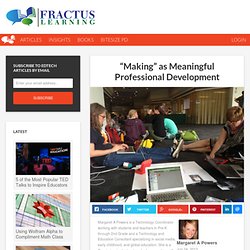
Maybe your answer to that question is “never” but after attending Constructing Modern Knowledge (CMK) this past week, I can thankfully say, “a few days ago!” CMK is truly a meaningful professional development experience and one where experience (through making) is the key word. Making is at the core of the entire week and instead of running from session to session or listening to long panels, the majority of our time was spent creating, exploring, failing, trying again, and sharing.